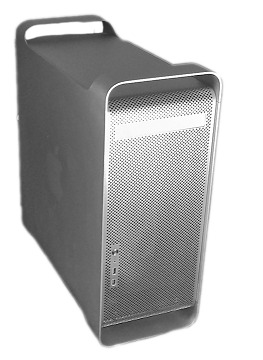#and doing all my editing in an ancient copy of CS2
Text
Oakweave set 2






them
(Gale's little smile when they touch foreheads!!!)
~~
More Oakweave:
First photo set
Third set
Fourth set
Fifth set
#bg3#bg3 photography#oakweave#halsin x gale#halsin silverbough#gale dekarios#can't sub to ffxiv?#use another game to feed your insatiable need to gpose#honestly tho i'm proud of how these turned out for not having that camera mod#and doing all my editing in an ancient copy of CS2
102 notes
·
View notes
Text
Meet the Mac
PowerMac G5 2.0 DP Early 2005 M9747ll/A A1047

The Specs
The early 2005 PowerMac G5 2.0 DP introduced in April 2005 with dual PowerPC 970 fx G5 processors running at 2 GHz. The base model came with 512 MB of PC3200 DDR memory, clocked at 400 MHz. I’ve upgraded my machine to the maximum supported amount of 4 GB. This model was discontinued in October of 2005.
This PowerMac shipped with Mac OS X 10.4 Tiger and supports up to version 10.5.8 Leopard. Applications designed for Mac OS 9 may be run in Classic mode, as this computer will only boot into OS X. I have set up my Mac to dual boot both Tiger and Leopard.
Storage was originally provided by an 160 GB 7200 RPM SATA hard disk, with a second bay available for an additional hard drive. I’ve installed two 1 TB hard drives to my system, allowing the two supported versions of OS X to each have their own drive. A 4X DL SuperDrive also came standard, enabling reading and writing to DVDs and CDs.
The G5’s graphics are powered by an ATI Radeon 9600 with 128 MB of VRAM, installed into an 8X AGP slot. This card provides two DVI ports, permitting either dual or mirrored displays at a maximum resolution of 1900x1200.
For networking, you get 10/100/.1000Base-T ethernet standard. AirPort Extreme wifi, Bluetooth, and modem were all optional and not originally installed on my machine. I have since added these.
Connectivity is fairly generous for a machine of the period, with 3 USB (2.0) ports, 2 Firewire 400 ports and a single Firewire 800 port.
For expansion, you get the aforementioned AGP 8X slot, occupied by the aforementioned ATI Radeon 9600. There are also 3 open PCI slots.
OK, that pretty much covers the specs, Let’s take a look at what you can actually do with this thing in the modern era.
The Internet
I’ll get this out of the way first: you’re not going to want to use this Mac as your daily driver on the internet. Safari, Firefox and Chrome all left the G5 behind along time ago. Internet Explorer? Even Microsoft has moved on from Internet Explorer. Sort of. But...There is a web browser actively supported for these machine. Built on an older version of Mozilla, TenFourFox is intended for PowerPC Macs running OS X Tiger or Leopard. It’s objective is to bring the modern web to these old Macs and, considering the limitations of the hardware, it doesn’t do a terrible job. Those hardware limitations are a pretty severe bottleneck, though. It’s just too slow to keep up with today’s internet. Social networking sites like Facebook and Tumblr don’t seem to function correctly. YouTube does technically work if you can accept watching videos at 144p. Higher resolutions bog the computer down to much, leading to buffering or choppy video. Basic, text heavy sites work tolerably well, though, and I have done quick research on the web while working on other projects on this machine. Still...Verdict: No.
Video Editing.
Ha ha ha ha ha ha ha ha . No.
Audio Processing
My needs in this area are very simple., and, I’ve been able to do very basic audio recording and editing on this Mac using a Blue Snowball USB microphone and Audacity. A quick note, though: if you’re Audio files absolutely need to be in MP3 format, Audacity requires the LAME library for MP3 encoding, which I have not been able to get to work with the old version of the software compatible with this old machine. I’m not saying it can’t be done. I’m saying I haven’t been able to figure out how to do it. Verdict: meh.
Retro Gaming
From a hardware perspective, this Mac should be a pretty capable retro gaming rig. The chief problem here is simply the availability of games for the platform. Game studios tend to focus resources on where the customers are, and in the computer gaming world, that’s going to be Windows and gaming consoles. Back in 2005, the Mac community mainly got ports of games that had already been out for other platforms for some time already, sold for full “new game price”, of course. If retro or any other type of gaming is your primary interest, the Mac probably isn’t be your first choice. Still, it’s not a total wasteland out there. MacSoft put out some decent ports - Civilization IV? OK, I’m in for that. Verdict: meh.
Office
I spend most of my time on this Mac in OS X Tiger. The two office suites I’ve found available for this operating system are Office 2004 and an equally ancient (4.0.6.2) version of Open/LibreOffice. Whether this PowerMac can meet your needs in this area depends on, well, what you need. I use Office 2004, which includes Word, PowerPoint and Excel, and for me, that does pretty much everything I need it to. This old version of Office can’t open anything saved in Microsoft’s XML format, though. Those can be identified by an x at the end of their filename extensions, such as .docx for a Word document. OpenOffice can deal with these files, so if you find yourself frequently exchanging files with other people, that’s probably the way to go. Verdict: Qualified yes.
Desktop Publishing
Ah, now we’re getting to what I consider the Mac’s strong suit - desktop publishing. With the right software installed, this old Mac is still pretty capable. I got lucky and was gifted a G5 with Adobe Photoshop CS2. That’s CS2 as in “Creative Suite 2”, so, it’s the bundle - Photoshop, Illustrator, Acrobat Pro, and InDesign. I once read something to the effect that “your Mac will always do the things it did on the day you bought it just as well years later.” That’s not absolutely true - see Internet and Video Editing - but here I think that statement holds up. I’ve used this Mac to create newsletters. My typical workflow looks like this: rough drafts of articles are written in Word. I’ll also handle the proofing in Word (if InDesign has proofing features, I haven’t found or seen a peep about them anywhere.) I’ll copy and paste these into InDesign, and begin to design the layout. I’ll use Aperture for quick touch-ups to photos (color or contrast adjustment, brightness, etc.) while actual photo editing (cropping, compositing, etc.) is done in PhotoShop. I’ll then import these into InDesign and finalize the layout. Although very old, these are professional grade tools. Could a professional use them in 2020? That might be a bit of a stretch, but a hobbyist can absolutely use them. Verdict: Yes
Conclusion
Hardware and software limitations make this Mac poorly suited for the modern web. Limited availability of software hobbles it’s capabilities as a retro gaming rig. But, for basic office duty and desktop publishing tasks, this old Mac can still be a productive member of the family.
2 notes
·
View notes